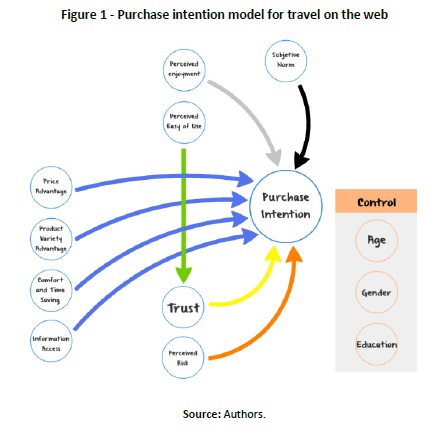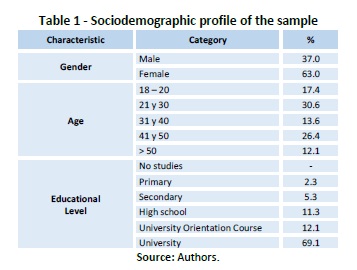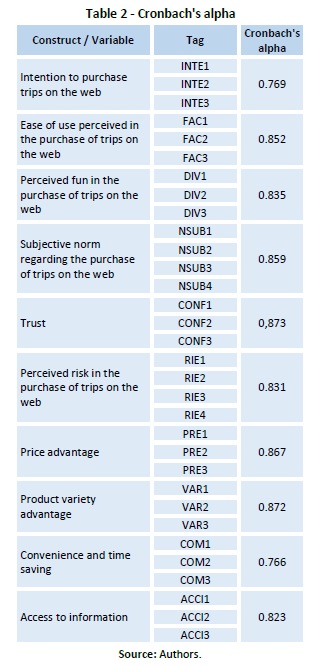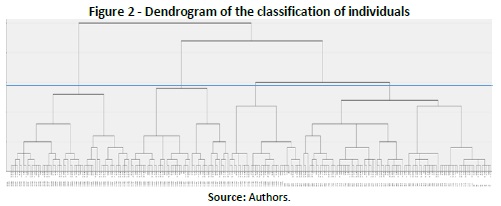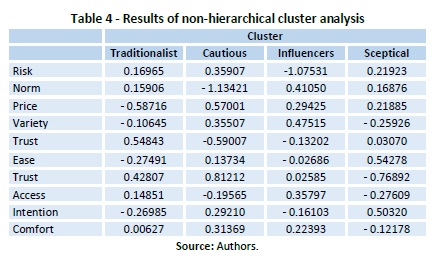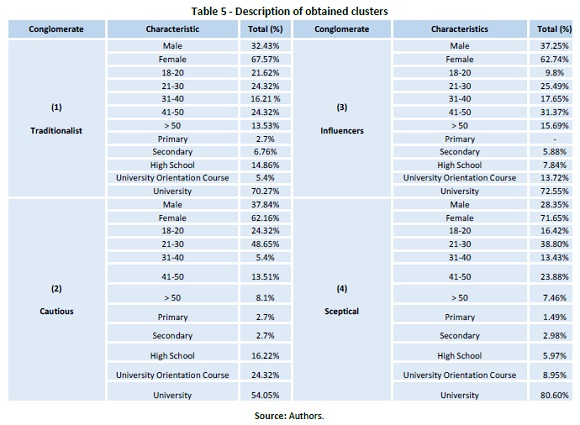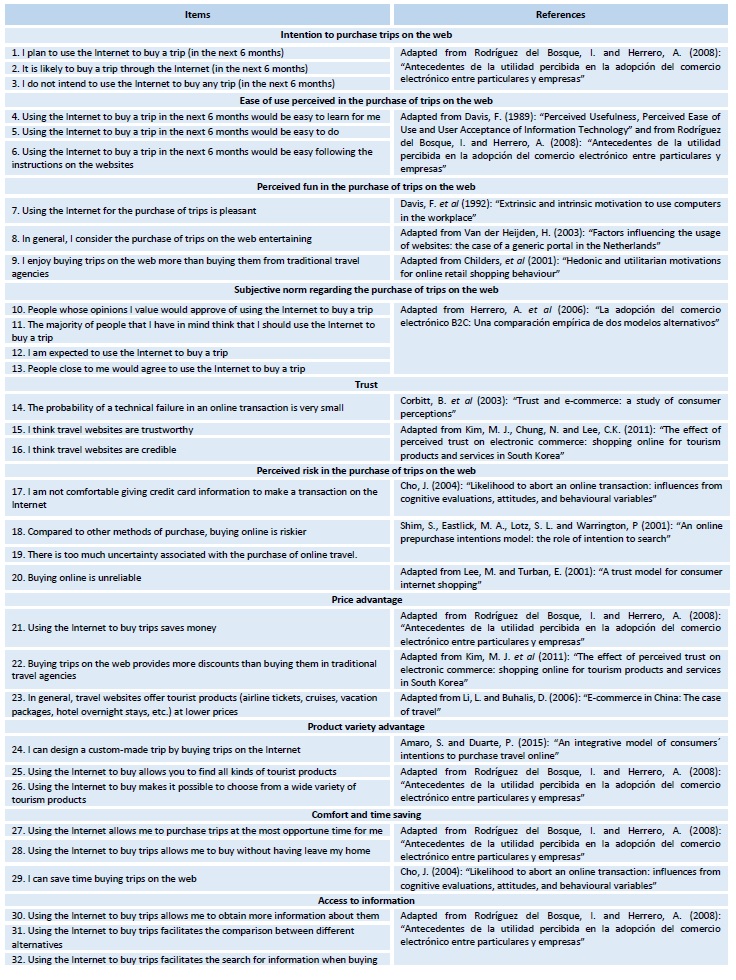Serviços Personalizados
Journal
Artigo
Indicadores
-
 Citado por SciELO
Citado por SciELO -
 Acessos
Acessos
Links relacionados
-
 Similares em
SciELO
Similares em
SciELO
Compartilhar
Tourism & Management Studies
versão impressa ISSN 2182-8458versão On-line ISSN 2182-8466
TMStudies vol.15 no.1 Faro mar. 2019
https://doi.org/10.18089/tms.2019.150102
TOURISM: SCIENTIFIC PAPERS
Analysis of the intent to purchase travel on the web
Análisis de la intención de compra de viajes en la web
German Gemar1, Ismael P. Soler2, Laura Melendez3
1University of Malaga, Department of Economics and Business Administration, Spain, ggemar@uma.es
2University of Malaga, Department of Applied Economics, Spain, ipsoler@uma.es
3University of Malaga, Spain, azul_laura@msn.com
ABSTRACT
The role of the Internet in the development of global markets offers a valuable object of study. This is especially true for tourism, both because of its contribution to the Spanish economy and because its intangible nature makes the Internet the most effective dist ribution channel for it. To help companies differentiate their websites, this work proposed a model of purchase intention, which includes the determinants of that intention. Cluster analysis was performed on a representative sample to sort potential and current consumers of online travel into groups based on their perceptions of the factors of the model. While young consumers see purchasing tourism - related services on the Internet as easy and cost-effective, contrary results are obtained for the elderly. However, the perceived risk is relevant for most individuals. In order to optimise the benefits of e - commerce, companies must build strategies that meet the expectations of each type of client.
Keywords: Cluster analysis, e-commerce, purchase of trips, purchase intention, integrated model.
RESUMEN
El desarrollo de mercados globales debido a Internet hace interesante su estudio, especialmente en torno al turismo, no sólo por la contribución de este sector a la economía española, sino también por la naturaleza intangible de los servicios ofrecidos, haciendo de Internet el canal de distribución más efectivo. Para que estas empresas diferencien sus páginas web, se ha propuesto un modelo de intención de compra que incluye factores determinantes de dicha intención, recogidos en la escasa literatura del comercio electrónico de viajes. El análisis clúster sobre una muestra representativa de potenciales y actuales consumidores de viajes online permite obtener diferentes grupos, y según sus percepciones de los factores del modelo. Mientras que los más jóvenes perciben una mayor facilidad y ventaja en precios en esta compra, se obtienen resultados contrarios para los de mayor edad, aunque el riesgo percibido se presenta relevante para la mayoría de individuos, lo que determina la necesidad de que las empresas fijen estrategias que satisfagan las expectativas de cada tipo de cliente.
Palabras clave: Análisis clúster, comercio electrónico, compra de viajes, intención de compra, modelo integrado.
1. Introduction
The importance of the Internet in recent years has increased to acquire the status of a tool whose use exceeds that of a mere information system. Several studies have highlighted the increased importance of electronic commerce, also known as e- commerce (e.g. BBVA Research, 2016; PWC, 2016), in which the purchase of trips and other products related to tourism, lead online shopping year after year (ONTSI, 2017). Tourism, in the case of Spain, has core importance both concerning the Gross Domestic Product (GDP) and to its capacity to generate employment, with a contribution of 10.9% and 12.7% of the total, respectively, in 2014 (INE, 2016). However, travel companies still face serious problems in taking advantage of the opportunities offered by e-commerce, as they lack experience with online sales (Millán, 2013) and must contend with the question of customer loyalty in an online setting (Valls, 1996).
For online travel marketing companies to take advantage of the potential of the Internet, overcome the problems mentioned above, and increase customer loyalty, it is essential, in addition to maintaining continuous contact with current or potential customers, to learn which factors are most influential on these customers’ intentions to buy trips on the web. This knowledge will allow for the establishment of a taxonomy of potential clients and will help to develop strategies adapted to the characteristic features of those clients, with the ultimate goal of promoting the purchase of trips through the websites of travel marketing companies.
Therefore, a theoretical model of intent to purchase online travel is proposed, formulated from the Theory of Planned Behaviour (Schifter & Ajzen, 1985) and the Technology Acceptance Model (Davis, 1989), together with other constructs included in later researches that succeeded these two. This model will be evaluated through factor analysis, subsequently segmented through cluster analysis, to learn the attitude of each subgroup towards the different constructs. This differentiation of groups and their attitudes will provide travel companies with a better understanding of the factors related to the intention to acquire travel (from the perspective of demand). This knowledge will allow businesses to adapt their online offers according to the characteristics of each group.
2. Conceptual framework
Consumer behaviour towards the Internet and e-commerce is explained by models that have been expanded to adapt to different scenarios. This work uses as its conceptual framework Ajzen’s (1985) Theory of Planned Behaviour (TPB) and Davis’s (1989) Technology Acceptance Model (TAM), expanded with significant external aspects of other works, such as those concerned with perceived fun/enjoyment (Van der Heijden, 2003; Teo, Lim & Lai, 1999; Childers, Carr, Peck & Carson, 2001; Cho & Agrusa, 2006), the perceived risk of the Internet purchase (Pavlou, 2003; Amaro & Duarte, 2015; Lin, Jones & Westwood, 2009) and trust in new technologies (Gefen, Karahanna & Straub, 2003; Bigné, Ruiz, Sanz & Aldás, 2010; Kamarulzaman, 2007).
TPB, an extension of the Theory of Reasoned Action (TRA), is based on the conceptual chain of Belief-Attitude-Intention- Behaviour to explain the actions of individuals (Ajzen, 1985; Schifter & Ajzen, 1985). Like its predecessor, TPB suggests that the intention to behave in a concrete way is generated by an attitude based on specific beliefs and subjective norms (Ajzen & Fishbein, 1980), but it adds the construct of perceived control as a determinant of intention and behaviour (Taylor & Todd, 1995). This construct is based on the fact that individuals do not always control their actions, being limited by other factors. It generates greater predictive and explanatory power than TRA by introducing other factors of intention.
As is the case of TPB, the Technology Acceptance Model (TAM) is based on TRA and also uses as its starting point, the conceptual chain of Belief-Attitude-Intention-Behaviour on which TRA is based. TAM adapts the conceptual chain of Belief-Attitude-Intention-Behaviour to the behaviour of individuals towards the new technologies and focuses on intention as the determinant of this behaviour (Davis, 1989; Davis, Bagozzi & Warshaw, 1989). The greater concreteness of the TAM makes it possible to predict and clarify better than other models the acceptance or rejection of technologies such as the Internet (Herrero, Rodríguez del Bosque, & Trespalacios, 2006). This model suggests that attitude, and therefore intention, is determined by the perceived ease of use and the perceived utility of a technology. Davis (1989) conceives ease of use as the degree to which the individual expects the use of technology to involve less effort than alternatives, and utility as the extent to which an individual feels technology can improve their performance in a task. One of the biggest criticisms of the TAM is based on its failure to consider the relationship between the purchase intention and the subjective norm, a relationship of great importance in light of the power that can be exercised by the media or even society as a whole (Kim, Kim & Shin, 2009). Some authors have pointed out as positive the integration of both, TAM and TPB models, giving rise to a broad vision of the general behaviour of individuals and the adoption of new technologies (e.g. Mathieson, 1991; Taylor & Todd, 1995) taking advantage of both (e.g. Davis et al., 1989). This is the point of view of the present work, and for that reason, the analysis model, included in Figure 1, uses as its basis incorporation of the purchase intention construct with the nine latent variables collected from the different models.
The variables of price and variety advantage, comfort/time saving, and easy access to information represent, within the TAM literature, key components of perceived utility. Rodríguez del Bosque and Herrero (2008) and Ruiz and Sanz (2006) define these variables: The advantage in price is represented by the possibility of finding lower prices, as well as promotions and offers, on the Internet; the variety of the offer is related to the ability of the Internet to offer a wider selection than that available within the physical limitations of a conventional store; convenience and time savings derive from the ability to purchase products and services over the Internet at any time and from anywhere; and finally, the easy and quick access to information on the Internet decreases information costs and improves efficiency.
Perceived ease of use is another construct of the TAM, which indirectly influences the intention to adopt new technologies (Davis, 1989). This facility consists of the belief that using new technology will require relatively little effort and will not be difficult to learn (Izquierdo, Martínez & Jiménez, 2010). An indirect relationship between perceived ease of use and intention through trust and perceived fun is proposed in the model. No direct relationship between ease of use and intention is proposed since due technologies tend to become increasingly accessible and easy to use as they persist in the marketplace, this factor might be relevant only in the first few years after the introduction of a particular technology (Teo et al., 1999).
Perceived fun is an element of the TAM that refers to the hedonic perspective. This is significant in the study of the tourism sector because of the relationship of tourism with free time, new experiences or entertainment. This element means that consumers enjoy the distraction inherent in the use of the Internet as an aspect of their hedonic tourism experience. Davis, Bagozzi and Warshaw (1992) added this construct to the TAM as an intrinsic source of motivation. In general, people will intend to use new technologies if they associate entertainment with their use (Teo et al., 1999), as those who look for hedonic motivations are also those who most value multimedia, interactive or contact content in websites. Teo et al. (1999) and Van der Heijden (2003) confirm the relationship between ease of use and perceived fun, with no entertainment value found in new technologies that are difficult to use.
Instead, the subjective norm originates from the TPB. When an individual perceives that his or her referents, those persons or groups of people whose beliefs are important to the individual (Mathieson, 1991), thinks a particular behaviour should be performed, he or she tends to act according to social pressure. The purchase of online travel would be linked to the degree to which the individual can, from the pressure exerted by relevant people, conceive the Internet as the optimal channel to make this purchase. Likewise, the purchase of trips on the web as a result of pressure from others could generate the belief of belonging to a social group, which could be used by companies to boost purchases by highlighting they are made by people who are either perceived by society as a whole as belonging to higher social groups or who may be recognised as experts in travel.
Perceived risk, usually used to expand TAM (Pavlou, 2003; Amaro & Duarte, 2015; Lin, Jones & Westwood, 2009), refers to the use of the Internet as a means of purchase, and not to the risk that arises from the trip itself (Amaro and Duarte, 2015). This creates an inverse relationship with the intention of buying online travel, as it is a multidimensional construct that makes possible losses associated with the purchase through the Internet (Bigné et al., 2010). This potential for loss would diminish the intention of consumers to buy online; similarly, reducing the potential for loss would increase the willingness to buy (Pavlou, 2003). Some of the potential risks include financial harm, adverse psychological effects and the waste of time or effort (Forsythe and Shi, 2003). Another element of the model, trust, is the willingness to be vulnerable to the actions of another, with the expectation that the other party will act beneficially for those who trust, whether or not they have the ability to control the other party (Mayer, Davis and Schoorman, 1995). Both concepts are related, justifying their inclusion by the uncertainty linked to electronic commerce, and reducing this uncertainty as confidence in the purchase increases (Kamarulzaman, 2007).
3. Methodology
3.1 Data
In order to comply with the proposed objectives, the present research distributed a self-administered online survey during the last quarter of 2017. This survey was directed towards people over 18 who had already purchased an online trip or had the intention of doing so. It was required that the analysed population use the Internet daily or who habitually made online purchases. These criteria were met by a large number of people (265 respondents) who were not opposed to using the Internet as a shopping channel. However, 36 outliers were identified and were eliminated so as not to distort the subsequent analysis, leaving a total of 229 observations. In this study, travel marketing companies are defined as those companies which provide services (related to airlines or hotels, for example) to travel agencies, and which have a website where travel can be acquired; that is, they are involved in tourism e-commerce. This survey consisted of two parts which were meant to assess the constructs of the model of this study: the first concerned the sociodemographic characteristics of the sample population, and the second included items with which the respondents indicated the degree of their agreement or disagreement.
The number of items included in the survey was thirty-two, and the degree of agreement towards them was measured using a Likert scale of 1 to 5, where 1 indicated "Total Disagreement"; 2 indicated "Fairly Disagree"; 3 indicated "Neither agree nor disagree"; 4 indicated "Fairly Agree"; 5 indicated "Total Agreement". The third item, which concerns the intention to purchase travel on the web, was formulated in the opposite direction, with which the values of the scale indicated was also invested when the results of the surveys were analysed with the SPSS program. The scales of measurement for the items (see Appendix 1) were extracted and adapted from previous research and similar scales, guaranteeing, that these scales had been developed by experts and had passed through a pre-test phase ensured that the items would be correctly interpreted (Fernández, 2004).
3.2 Method
The use of the measurement scales described above allowed a factorial analysis to be carried out with the principal component method and an orthogonal rotation Varimax. This technique allows for the identification of structures constituted by the factors (Hair, Anderson, Tatham and Black, 1999). The well-known Cronbach’s alpha was used (1951). Moreover, to evaluate the validity of the constructs, both the Kaiser-Meyer-Olkin (KMO) test for sampling adequacy and Bartlett's sphericity test were used to determine whether it was pertinent to perform the factorial analysis on the variables (Pérez, 2001). The KMO test helps to determine whether the data are apt to adapt to a factorial model, whereas the value of Bartlett’s sphericity test can refute the hypothesis of variables not initially correlated (Soler & Gemar, 2017). The matrix of rotated components shows whether the items are grouped in the factors identified in the model, by showing factorial loads close to +1 or -1 according to the orthogonal rotation method used, with a greater link between the item and the factor if the weights get closer to +1 or -1, and a lesser link the closer they get to 0 (Hair et al., 1999).
Subsequently, a cluster analysis was carried out to classify the attitude of each homogeneous group towards the constructs (Pérez, 2001 A homogeneous group is one including respondents who share common characteristics, while a heterogeneous group includes respondents may belong to different conglomerates (Hair et al., 1999). As is common, the cluster analysis was carried out in two stages (e.g. Lee & Ro, 2016; Masiero, Pan, & Heo, 2016; Soler, Gemar, & Jimenez- Madrid, 2017). In the first stage, a hierarchical cluster analysis was performed using Ward's method. Based on the distances of increasing cluster junctions between clusters, i.e., it is increasingly difficult to find similarities between the groups, the optimal solution was fixed in 4 clusters.
A non-hierarchical cluster analysis was then performed with the k-means grouping method, using the Euclidean square distance. Analysing these results reveals the general attitude of the individuals of each group towards the constructs through the centres of the final conglomerates. The analysis of these conglomerates will allow the individuals to be classified according to the gender, age and educational level, and to understand the distribution of the individuals in the groups according to these features.
4. Results
Table 1 shows the sociodemographic profile of the sample. The sample was more heavily composed of women, at 63%, than men, at 37%. The range of ages between 18 and 30 years compose 48% of the total sample. The education level of the sample was predominantly that of university student or graduate, at 69%.
The results of the Cronbach's alpha were higher than 0.7 and 0.8, placing all the cases at levels between acceptable, for the constructs of intent to purchase on the web and convenience and time-saving, and good for the rest of the items (Table 2).
With regard to the results of the factorial analysis, the KMO test reached a value of 0.916. By varying this statistic between 0 and 1, reaching a value close to 1, the data are susceptible to a reduction of variables through factorial analysis to form the factors. Bartlett's sphericity test contrasts the null hypothesis that the matrix of correlations is an identity matrix, which, if accepted, would suppose the existence of null correlations between the variables. When the p-value is less than 0.05, this null hypothesis is rejected, determining the adequacy of the data to the factorial model (Pérez, 2001).
The matrix of rotated components collected in Table 3 generates the same grouping of items made in the measurement scales. Although factorial loads lower than 0.5 are obtained, since the sample size is higher than 250 observations (265), significant factorial loads are higher than 0.35, which allows an affirmation, in this case, of the relationship between items and factors (Hair et al., 1999). Thus, the information obtained from the ten factors can be suitably summarised, coinciding with the ten initial constructs, the cluster analysis is carried out from those constructs included in the analysis model, evidencing the validity of the content of the scales used.
Regarding the cluster analysis, in Figure 2, it is possible to see the dendrogram and the cut-off line. The optimal decision was between 3 and 4. Since choosing 3 conglomerates would mean that one, the result of the union of several large clusters, would group practically half of the sample population, we chose the solution of 4 clusters for the sake of maximising the internal homogeneity of each group.
The analysis of the centres of the final conglomerates reveals the general attitude of the four groups or conglomerates, according to each construct of the model, and, therefore, the attitude of the individuals that constitute these groups, according to the values of the matrix a - 1.5 or +1, as shown in Table 4. For the interpretation of the values that both figures show below, values close to -1.5 will be taken as non- conforming and those close to +1 as conforming.
Once the attitude of the individuals that have been classified in the four clusters are described based on the cluster analysis, the socioeconomic characteristics of each of the groups were included in Table 5 below.
5. Discussion and conclusion
The cluster analysis allowed the conglomerates to be described according to their attitudes shown in general lines towards the constructs of the analysed model. This knowledge offers promising implications for businesses, which can use it to boost the purchasing intentions of consumers and enhance their desire to make repeat purchases. These findings suggest that it is possible to differentiate the attitudes of the four conglomerates towards the online purchase of trips and the constructs involved in making such a purchase:
· Traditionalist: This is the group which disagrees most significantly with the constructs of advantage in prices, variety of offer, perceived ease of use and intention to purchase trips on the web. These users show a lower intention to buy trips on the web and do not consider that the Internet facilitates the purchase of trips when compared to other, more traditional channels. It is important to note that, contrary to what might be expected, this group shows greater confidence on the Internet as a purchasing system, a finding which highlights its credibility concerning travel web sites and the transactions carried out in them.
· Cautious: This group indicates particular disagreement towards the role of subjective norm, so that, in general, these individuals do not think that their referents influence their decisions to buy trips on the web. They do not question the ability of the Internet to offer lower prices than traditional agencies. However, they show the least trust in the purchase of trips on the Internet; they perceive a higher risk of technical failures during the transactions, or that the credit card information they provide might be misused. Besides, these individuals perceive buying travel online as both easy and fun.
· Influencer: This group is the one that perceives the lowest risk in the purchase of trips on the Internet, which suggests that they do not feel the sense of uncertainty that the other conglomerates link to the web in general. In addition, this cluster considers the subjective norm as a relevant factor in the intention to purchase trips on the web and recognises the influence of both referents and social pressure on decisions to buy trips on the Internet. Also noteworthy that these individuals are those who consider visibly that online shopping offers a wide variety of both travel and other services, as well as more information about trips and other tourism products compared to other shopping channels. This conglomerate, like the Traditionalists, does not believe that the purchasing trips is easier through the Internet than it is through other shopping channels. However, both groups agree that the Internet makes it possible to access more information about travel products.
· Sceptical: This group finds no entertainment value at all in buying trips on the web, in addition to not believing that the Internet offers more information than they would be given if they went directly to traditional travel agencies or any other travel sales channels. These individuals do not find that buying trips on the web is necessarily more comfortable, either in terms of time or travel, than if the purchase were made through traditional channels. Despite this, these individuals do agree that there is greater ease associated with the acquisition of online travel and showing a strong intention to acquire trips on the Internet in the next six months. According to the results, the Cautious and the Sceptical agree that online travel purchases both offer a price advantage and come with certain risks. Both conglomerates also agree on the ease of acquiring trips on the web, while neither feels that this medium provides them with more information than traditional channels.
The subjective norm is especially relevant in the clusters with the highest percentages of university students, and also in those that include individuals of more advanced ages. This seems to go against the general view that Generation Y is the one that places the most significant emphasis on social risk and is the most rational one when it comes to choosing retailers (Parment, 2013). It is possible that the ability to travel more or to dedicate more of its budget to trips makes this group more sensitive to the subjective norm.
If people tend to buy trips on the web moved by other people who are relevant to them, it is recommended that companies take advantage of this fact by establishing a more significant online presence, especially in virtual travel communities. These online travel communities, featuring the opinions of individuals who had already acquired trips on the company website, might encourage others to perceive to perform this same behaviour. This approach would be most effective if the potential buyers perceive past buyers as referents. In such a setting, travel can be promoted through the exchange of information, experiences, opinions and photographs (Lin et al., 2009) and the construction of familiarity among clients. It is a recognised fact that this type of information sharing favours positive behaviours, increasing the credibility of the company and developing long-term relationships between company and clients, and with them, client loyalty. With regard reduce users' perceived risk, Amaro and Duarte (2015) point out that the improvement of a company's reputation; that can result for example from cooperation with others of recognised prestige; and the increase of privacy that would arise from systems that guarantee the responsible capture and use of customer information, favour transparency, and increase the trust towards online shopping, may reduce the perceived risk associated with the online purchase.
That the subjective norm is an important force in purchasing decisions is clear. It is important to note that referents are not only those with close relationships to an individual but include those perceived as superior socially or educationally as well. Companies should publicise the purchases made by experts or members of higher social groups in order to create in existing and potential clients the feeling that, when purchasing trips on their website, they belong to such groups. That is, companies would encourage people to find buying online travel advantageous, by hearing about its benefits from those individuals whose opinions are relevant to them. Companies should also try to include famous people in their advertising campaigns to emphasise the advantages of this type of purchase, so that consumers, especially those who give more relevance to this construct according to the results, can identify with figures such as experts or opinion leaders. By broadening its presence in media such as television, a company can further increase the pressure on the individual to buy, resulting in a higher likelihood of considering the Internet as an optimal travel purchase channel.
Regarding the constructs that constitute perceived utility (an advantage in prices, variety of offers, convenience and time saving and access to information), companies must be able to communicate clearly to consumers the advantages of buying travel through the web. For this, they can use the weight of the subjective norm or develop a strategy based on low prices (Amaro & Duarte, 2015), and discounts (Ruiz & Sanz, 2006;
Rodríguez del Bosque & Herrero, 2008). Because of the dominance of the Internet as a means of information searching, these companies should take advantage of every casual visit by offering a wide variety of travel offers and additional services, such as tickets to museums or theme parks. In addition, it is worthwhile for a company to maintain accurate information on its website so that visitors could enjoy the search experience, one free of errors or inconsistencies, which could be transformed into a purchase. (Lin et al., 2009). The constructs of convenience and time saving, important in almost all conglomerates, makes it necessary for consumers to enjoy a pleasant and short purchase, either by reducing the time required to purchase the trip or the steps to be carried out; both of these are possible with the use of efficient booking engines (Kim et al., 2009; Lin et al., 2009).
Along these same lines, companies must provide the media with an experience that is entertaining. Because of the entertainment perceived in the use of the Internet, companies that sell trips via e-commerce have to use their web pages to promote the fun that allows individuals to escape from their daily routine (Cho & Agrusa, 2006), encouraging the intention of buying online and making the process more enjoyable. The Internet offers a variety of entertainment possibilities; though it is an intangible medium, it allows different sensations from stimuli such as photographs or videos. Whatever secondary benefits the website may provide, every part of it ultimately supports the online sale of travel, so that consumers, despite being unable to know the exact characteristics of these services (which is not the case with tangible products), can get an idea of them by means of the multimedia content established by the company. This approach could also act as a bridge to mitigate the risk associated with online shopping, which is understood, both traditionally and according to the results of the present study, as a major impediment for almost all Internet users. The travel companies should use a range of means to reduce this risk, to increase the confidence of visitors. These methods could include providing clear information that facilitates the consumer's acquisition of online travel, or through such factors like the reputation of companies, their perceived fun or familiarity with them (Gefen et al., 2003; Pavlou, 2003).
According to the results of the present study, the conglomerates with more people between 18 and 30 years are those that agree most strongly that the Internet makes it easy to buy travel, which could be associated with the greater use of new technologies by this younger segment of the population. To attract people, especially older ones, who do not see using the Internet as an easy way to buy travel, the companies should establish a simple web design easy to understand and use, which will at the same time increase trust and a sense of fun. Gefen et al. (2003), Kamarulzaman (2007) and Bigné et al. (2010) confirm that an easy-to-use website is associated with a merchant who takes care of the consumer, and better functionality will allow more entertainment to be perceived. While the easy-to-use does not necessarily have a direct influence on the purchase intention, companies should still endeavour to make the shopping experience easier by promoting simplicity in browsing and booking on their websites.
Travel companies should try to integrate as many actions related to the factors of the present model as they can. However, they should not limit themselves to the implications which have been discussed above, since maintaining these actions over time and adding new ones will allow them to differentiate the use of their website from their competitors. This will result in competitive advantages, which, if maintained over time, would become sustainable. However, due to the use that many companies currently make of the web, especially those that sell travel, attracting the attention of their visitors is an arduous task, especially if they seek to build loyalty. It requires an innovative capacity to excel in the long term and, as the virtual environment and associated technologies are always changing, these companies must always be on the alert.
The main limitations of the paper derive from the methodology used. On the one hand, factor analysis is conceived as a general diagnostic method that simplifies reality by eliminating part of the variance of the original set of variables. It is possible that a method with higher predictive power, such as the partial least squares model (PLS), could, once the general structure of the model is known, yield more profuse results and better predictive capacity. It could be interesting for future research in this field to apply a PLS model with objective market-based variables, such as the actual purchase of online travel.
Similarly, cluster analysis calls upon the researcher's judgment to determine the correct number of clusters, and the results depend to a large extent on the quality of the variables used. In this case, new variables could produce different results. It could be worthwhile in future studies to evaluate whether the results differ between those who have already acquired online travel and those who have never yet done so.
The sample of the present study was heavily weighted toward women and people who reported university as their highest level of educational attainment. To obtain a more balanced and representative sample of internet users, studies that establish a profile of Spanish netizens, both buyers and non-buyers, could be used as references to adjust the profile of subsequent studies concerning the intention to buy.
New technologies, especially those associated with the Internet, have created a variety of ways to understand how consumers and businesses engage in trade; this knowledge can be of particular value to the tourism sector. Those who use the Internet as a shopping channel will gain advantages, including saving time and effort in making the purchase, while those companies that practice e-commerce can increase their profits and retain customers if they manage to offer a unique and satisfactory experience that extends beyond using the Internet as a simple information channel. In this study, an integrated model has been proposed that represents the general and specific behaviour of individuals towards new technologies, specifically towards the Internet as a travel purchase channel. By identifying groups representative of those who have purchased trips online or plan to do so, this study has permitted a better understanding of the determinants of consumer intention. It has clarified the perception of each group towards particular factors, and this enables the elaboration of managerial implications for travel marketing companies of any size or in any location. The study takes account of the dynamic character of this type of purchase and the need for companies to maintain continuous innovation.
Companies can address the uncertainty associated with purchasing travel online perceived by nearly all consumers. The actions developed by companies should not be isolated, but should instead ideally involve the periodical assessment of new trends or innovations that could change the perception of consumers towards the purchase of trips on the Internet and lead them to buy. Therefore, this work contributes to the body of research concerning shopping on the web by providing a broad view of the perspective of consumer tourism. This enables companies to acquire knowledge of possible strategies or actions to develop in the virtual environment, allowing them to attract, retain and satisfy customers.
REFERENCES
Ajzen, I. (1985). From intentions to actions: A theory of planned behavior. En Action control (págs. 11-39). Berlin: Springer Berlin Heidelberg. [ Links ]
Ajzen, I. & Fishbein, M. (1980): Understanding attitudes and predicting social behavior, Englewood Cliffs: Prentice-Hall. [ Links ]
Amaro, S. & Duarte, P. (2015): “An integrative model of consumers’ intentions to purchase travel online”, Tourism Management, 46, 64-79.
Bigné, E., Sanz, S. Ruiz, C. & Aldás, J. (2010): “Why Some Internet Users Don´t Buy Air Tickets Online”, Information and Communication Technologies in Tourism, 6, 209-221.
BBVA Research. (2016). Comercio electrónico y hábitos de consumo en España. Recuperado el 5 de Abril de 2017, de https://www.bbvaresearch.com/wp-content/uploads/2016/04/Presentacion_comercio_electronico_abr161.pdf [ Links ]
Childers, T. L., Carr, C. L., Peck, J. & Carson, S. (2001): “Hedonic and utilitarian motivations for online retail shopping behavior”, Journal of Retailing, 77(4), 511-535.
Cho, J. (2004): “Likelihood to abort an online transaction: influences from cognitive evaluations, attitudes, and behavioral variables”, Information & Management, 41(7), 827-838.
Cho, Y. C. y Agrusa, J. (2006): “Assessing Use Acceptance and Satisfaction Toward Online Travel Agencies”, Information Technology & Tourism, 8, 179-195.
Cronbach, L. J. (1951): “Coefficient alpha and the internal structure of tests”, Psychometrika, 16(3), 297-334.
Davis, F. D. (1989): “Perceived Usefulness, Perceived Ease of Use, and User Acceptance of Information Technology”, MIS Quarterly, 13(3), 319-340.
Davis, F. D., Bagozzi, R. P. & Warshaw, P. R. (1989): “User Acceptance of Computer Technology: a Comparison of Two Theoretical Models”, Management Science, 35(8), 982-1003.
Davis, F. D., Bagozzi, R. P. & Warshaw, P. R. (1992): “Extrinsic and Intrinsic Motivation to Use Computers in the Workplace”, Journal of Applied Social Psychology, 22(14), 1111-1132.
Fernández, A. (2004): Investigación y técnicas de mercado (2ª ed.), Madrid: ESIC.
Forsythe, S. M. y Shi, B. (2003): “Consumer patronage and risk perceptions in Internet shopping”, Journal of Business Research, 56, 867-875.
Gefen, D., Karahanna, E. & Straub, D. W. (2003): “Trust and TAM in online shopping: an integrated model”, MIS Quarterly, 27(1), 51-90.
Hair, J. F., Anderson, R. E., Tatham, R. L. y Black, W. C. (1999): Análisis Multivariante (E. Prentice & D. Cano, Trad.), (5ª ed.), Nueva York: Prentice Hall.
Herrero, A., Rodríguez del Bosque, I. A. & Trespalacios, J. (2006): “La adopción del comercio electrónico B2C: una comparación empírica de dos modelos alternativos”, Revista Española de Investigación de Marketing, 10(1), 69-91.
INE. (2016). Cuenta Satélite del Turismo de España. Base 2010. Instituto Nacional de Estadística. Madrid: Notas de Prensa. Obtenido de http://www.ine.es/prensa/np975.pdf [ Links ]
Izquierdo, A., Martínez, M.P. & Jiménez, A. I. (2010): “Condicionantes económicos de la adopción de una innovación por parte del consumidor: análisis de la compra de servicios online”, Innovar, 20(36), 173-186.
Kamarulzaman, Y. (2007): “Adoption of travel e-shopping in the UK”, International Journal of Retail & Distribution Management, 35(9), 703- 719.
Kim, H. B., Kim, T. & Shin, S. W. (2009): “Modeling roles of subjective norms and eTrust in customers’ acceptance of airline B2C eCommerce websites”, Tourism Management, 30, 266-277.
Kim, M. J., Chung, N. & Lee, C.K. (2011): “The effect of perceived trust on electronic commerce: Shopping online for tourism products and services in South Korea”, Tourism Management, 32, 256-265.
Lee, S. H., & Ro, H. (2016). The impact of online reviews on attitude changes: The differential effects of review attributes and consumer knowledge. International Journal of Hospitality Management, 56, 1-9. [ Links ]
Lee, M. & Turban, E. (2001): “A Trust Model for Consumer Internet Shopping”, International Journal of Electronic Commerce, 6(1), 75-91.
Li, L. & Buhalis, D. (2006): “E-Commerce in China: The case of travel”, International Journal of Information Management, 26(2), 153-166.
Lin, P. J., Jones, E. & Westwood, S. (2009): “Perceived Risk and Risk- Relievers in Online Travel Purchase Intentions”, Journal of Hospitality Marketing & Management, 18(8), 782-810.
Mathieson, K. (1991): “Predicting User Intentions: Comparing the Technology Acceptance Model with the Theory of Planned Behavior”, Information Systems Research, 2(3), 173-191.
Masiero, L., Pan, B., & Heo, C. Y. (2016). Asymmetric preference in hotel room choice and implications on revenue management. International Journal of Hospitality Management, 56, 18-27. [ Links ]
Mayer, R. C., Davis, J. H. & Schoorman, F. D. (1995): “An Integrative Model of Organizational Trust”, Academy of Management Review, 20(3), 709-734.
Millán, A. (2013): “Sistema de distribución comercial”. En ESTEBAN, A. y LORENZO, C. (Coord.), Dirección Comercial, (pp. 137-156). Madrid: ESIC.
ONTSI. (2017). La Sociedad en Red: Informe Anual 2016. Madrid: Ministerio de Energía, Turismo y Agenda Digital. Obtenido de http://www.ontsi.red.es/ontsi/sites/ontsi/files/Informe%20Anual%20La%20Sociedad%20en%20Red%202016%20%28Edici%C3%B3n%20201 7%29.pdf [ Links ]
Parment, A. (2013). Generation Y vs. Baby Boomers: Shopping behavior, buyer involvement and implications for retailing. Journal of Retailing and Consumer Services, 20(2), 189-199. [ Links ]
Pavlou, P. (2003): “Consumer Acceptance of Electronic Commerce: Integrating Trust and Risk with the Technology Acceptance Model”, International Journal of Electronic Commerce, 7(3), 101-134.
Pérez, C. (2001): Técnicas Estadísticas con SPSS (1ª ed.), Madrid: Prentice Hall.
Rodríguez del Bosque, I. A & Herrero, A. (2008): “Antecedentes de la utilidad percibida en la adopción del comercio electrónico entre particulares y empresas”, Cuadernos de Economía y Dirección de la Empresa, 11(34), 107-134.
PWC. (2016). Total Retail 2016. Recuperado el 7 de Abril de 2017, de https://www.pwc.es/es/publicaciones/retail-y-consumo/assets/total-retail-2016.pdf [ Links ]
Ruiz, C. & Sanz, S. (2006): “Influencia de las motivaciones en la decisión de compra y en la lealtad hacia Internet”, Investigaciones Europeas de Dirección y Economía de la Empresa, 12(3), 195-215.
Schifter, D. & Ajzen, I. (1985): “Intention, perceived control, and weight loss: An application of the theory of planned behavior”, Journal of Personality and Social Psychology, 49(3), 843-851.
Shim, S., Eastlick, M. A., Lotz, S. L. & Warrington, P. (2001): “An online prepurchase intentions model: The role of intention to search”, Journal of Retailing, 77(3), 397-416.
Soler, I. P., & Gemar, G. (2017). A measure of tourist experience quality: the case of inland tourism in Malaga. Total Quality Management & Business Excellence, 1-14. doi: 10.1080/14783363.2017.1372185
Soler, I. P., Gemar, G., & Jimenez-Madrid, A. (2017). The impact of municipal budgets and land-use management on the hazardous waste production of Malaga municipalities. Environmental Impact Assessment Review, 65, 21-28. [ Links ]
Taylor, S. & Todd, P. (1995): “Understanding information technology usage: a test of compiting models”, Information Systems Research, 6(2), 144-176.
Teo, T. S., Lim, V. K. & Lai, R. Y. (1999): “Intrinsic and extrinsic motivation in Internet usage”, Omega, 27(1), 25-37.
Valls, J.F. (1996): Las claves del mercado turístico: cómo competir en el nuevo entorno, Bilbao: Deusto. [ Links ]
Van Der Heijden, H. (2003): “Factors influencing the usage of websites: the case a generic portal in The Netherlands”, Information & Management, 40, 541-549.
Received: 28.06.2018
Revisions required: 12. 11. 2018
Accepted: 15.12.2018













